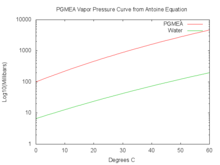Propylene glycol methyl ether acetate
 | |
| Names | |
|---|---|
| IUPAC name
1-Methoxy-2-propanyl acetate | |
| Other names
PGMEA; 1-Methoxy-2-propanol acetate | |
| Identifiers | |
| 108-65-6 | |
| 3D model (Jmol) | Interactive image |
| ChemSpider | 7658 |
| ECHA InfoCard | 100.003.277 |
| PubChem | 7946 |
| UNII | PA7O2U6S2Q |
| |
| |
| Properties | |
| C6H12O3 | |
| Molar mass | 132.16 g·mol−1 |
| Hazards | |
| Template:H226, Template:H360 , Template:H402 | |
| NFPA 704 | |
| Flash point | 43 °C (109 °F; 316 K) |
| 333 °C (631 °F; 606 K) | |
| Except where otherwise noted, data are given for materials in their standard state (at 25 °C [77 °F], 100 kPa). | |
| Infobox references | |
Propylene glycol methyl ether acetate (PGMEA, 1-methoxy-2-propanol acetate) is a P-type glycol ether used in inks, coatings, and cleaners. It is sold by Dow Chemical under the name Dowanol PMA[1] and by Shell Chemical under the name methyl proxitol acetate.[2][3]
In the semiconductor industry, PGMEA is a commonly used solvent, primarily for the application of surface adherents such as Bis(trimethylsilyl)amine (HMDS) on silicon wafers.[4] The compound is often the most abundant airborne, molecular contamination (AMC) in semiconductor cleanrooms,[5] due to its evaporation into ambient air.

Vapor Pressure Curve for PGMEA vs. Water
References
- ↑ http://www.dow.com/scripts/litorder.asp?filepath=oxysolvents/pdfs/noreg/110-00588.pdf
- ↑ http://s00.static-shell.com/content/dam/shell/static/chemicals/downloads/responsible-energy/methylproxitol-pgmemethylproxitolacetatepgmeaproductstewardships.pdf
- ↑ "Methyl PROXITOL".
- ↑ "HMDS primer (hexamethyldisilazane), DEATS and PGMEA".
- ↑ http://www.balazs.com/file/otherelement/pj/1_amc_guidelines_rev2.34642.pdf
This article is issued from Wikipedia - version of the 12/2/2016. The text is available under the Creative Commons Attribution/Share Alike but additional terms may apply for the media files.
